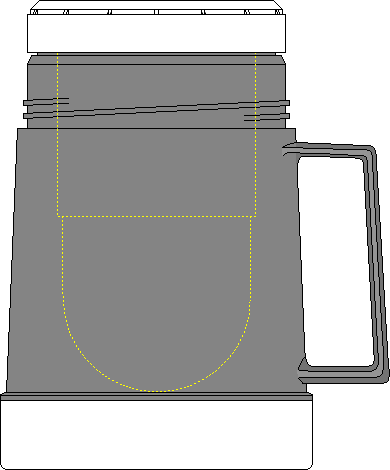I have used a "Thermos" brand flask that was intended for keeping soup hot (Model No. 70 - 50 Half Litre). I chose this type for it's broad and squat shape. The drawing below is conducted to a scale of 2.5 pixels per mm and shows the device without it's outer screw top, but I do always use the top for added security. The inside profile has a rounded bottom and there is a ledge about halfway up the interior (the dotted line).

In use I place a synthetic cellulose sponge in the bottom half of the flask's inner cavity and pour in hot water until the sponge is fully saturated. The water temperature, that I use, will depend on how long it will be before I expect to actually put queencells in the flask. I do not use a thermometer, guesswork has always been adequate. I then pour away any excess water and slide in a circular plug of plastic foam (as right) that has had deep, but narrow "V" shaped cuts made in it's top surface, in a 'criss cross' fashion. This makes it look a little like an egg box, the plug slides firmly into place in the upper part of the flask and sits on the ledge that is halfway down. The cells themselves are placed at the junctions in the matrix of slots, firmly, but sensitively... The tapered cells match the tapered shape of the cavities in the foam and provide total stability as each cell is held by four areas of linear contact. There is an air space above the cells and I have a disc of very flimsy compliant foam that was originally intended to sit on top of the cells whilst they were in transit, however I have never used it, nor have I seen any need for it.

Attitude...
Queencells should kept vertical at all times and all stages of development to ensure proper contact of the larva with the royal jelly within the cell.
Temperature...
Should be kept as close to hive temperature as possible, but temperature regulation is not critical over short time scales. If long distances and times are envisaged the problem becomes more that of a portable incubator rather than just transport.
Humidity...
This is another item whose importance varies proportionately with time. In my soup flask I used a sponge to hold the hot water so that the liquid did not slosh about. I suspect that the humidity in the flask was higher than natural hive humidity, but I have no recollection of any adverse effects.
Vibration...
I always coach beekeepers to brush bees from combs that may contain queencells, rather than shaking. And cells in transport should be protected from sharp knocks for the same reason. However the rhythmic vibration of a car engine does not appear to cause harm.
Frames of queencells may be transported in a modified picnic box (often called a 'cool' box) but with a hot water soaked towel in the base. This will keep the frames moist and warm.
I have looked many times for such a box that would carry B.S. frames... With the intention of adding battery power and solar recharging to run a thermostatically controlled incubator type carrying box. So far I have not found one that is suitable.